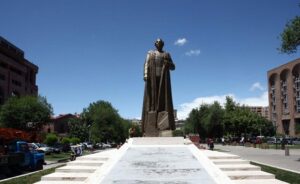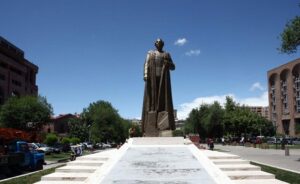 Tseghakron – was formed by combination of two Armenian words – “ցեղ” (race) and “կրոն” (religion). The movement founded by Garegin Nzhdeh (Garegin Ter-Harutyunyan) is called Tseghakron and his ideological doctrine – Tseghakronutyun (Tseghakronism).
Tseghakron – was formed by combination of two Armenian words – “ցեղ” (race) and “կրոն” (religion). The movement founded by Garegin Nzhdeh (Garegin Ter-Harutyunyan) is called Tseghakron and his ideological doctrine – Tseghakronutyun (Tseghakronism).
The Republic of Armenia determines its state policy based on this doctrine. The Republican Party of Armenia, led by President Serzh Sargsyan, sees Nzhdeh as their ideological leader. This person, who was not inferior to Andranik for cruelty, shed rivers of blood. Having moved from Tabriz to Sofia in 1922, Nzhdeh began to publish his first anti-Turkic and anti-Muslim articles. For example, “Heroic Battle of Lernhayastan Nagorno-Karabakh)” (Bucharest 1923), “Some Pages from my Diary” (Cairo 1924), “The Struggle of Sons against Fathers” (Thessaloniki 1927), etc. were widely covered in magazines and newspapers such as “Hayastan” (Plovdiv), “Araks” (Sofia), “Azatamart” (Paris) published by Dashnaks. All articles hadone target – Turks and Turkey, and had one goal – to create hatred in Armenians abroad against Turks and Turkey. After leaving Bulgaria for the US, Nzhdeh began to spread the doctrine there. Through this “theory”, Armenians approached racist Tseghakron to fascism.
Armenian-Nazi collaboration
The ideological foundation of the collaboration between the Nazis and Dashnaks began to be laid in the 1930s. A leading Nazi party ideologist Alfred Rosenberg assigned Artashes Abegian (Head of the Institute for Oriental Studies 1926-136) the task of setting up a committee to study the anthropology and history of the Armenians. Of course, Armenians assessed this opportunity greatly. A report was issued that they come from the same race with Germans. Five months after the committee was set up in 1934, Rosenberg submitted a report to Hitler indicating that the Armenians were of the same race as Germans.
Meanwhile, Armenians began to create fascist youth organizations and combat groups in Bulgaria and Romania comprised of members of the Armenian nationalist organization “Tseghakron”, who called on all Armenians worldwide to collaborate with the Nazis during World War II.
General Drastamat Kanayan (Dro), who fought against Turkey during and after World War I and dealt harsh with the Muslim population, established the Armenian National Committee on 15 December 1942 in order to represent the Armenians of Europe under the German government. This committee, during World War II, became an anti-USSR and pro-German center of propaganda. In February 1944, the United Armenian Headquarters was established on the order of Rosenberg. At the end of April 1943, the group assumed an independent status. The assistant to the head of the group (Dro) was Kuro (Nikolai Tarhanian) and the chief of staff was Tigran Bagdasarian. Misak Torlakian assumed the responsibility of intelligence and sabotage activities. The spy team of AG-114 was comprised of members of Dashnak Armenia’s (1918-20) military.
One of the major services rendered by the Dashnaks to the Nazis in World War II was their propaganda activity behind Soviet lines and in occupied territories. One of these teams was lead by the SS Officer Nikolai Gevorkian (Dr. Sikorsky Gevorkov), son of the famous Dashnak leader Seto Djelalian. They placed their agents among the Armenian population in occupied areas for counterintelligence activities. The Dashnaks did not neglect to run those prisoners of war who agreed to join their special units through some tests, to weed out Jews pretending to be Armenian. They had the prisoners who surrendered read the Bible they had with them in Armenian, to verify their true nationality.
Alongside general Dro, he also participated in forming Armenian armed units under Vermakht in 1942.
On 15 December 1942, Garegin Nzhdeh became one of seven members of the Armenian National Council established by Germans and deputy editor of “Independent Armenia” newspaper. Armenian paramilitary groups led by Dro and Nzhdeh were actively involved in operations to capture Crimea and attacks on Caucasus.
Germany’s leadership was going to use the Armenians in Caucasus and Turkey for raising a revolt in these countries, but the failures on the frontline forced them to abandon these plans.
As the Soviet Army entered Bulgaria, Nzhdeh wrote to the commander of the Third Ukrainian Front, Fyodor Tolbukhin, making himself available to the USSR in case of a possible attack against Turkey. However, the General was arrested and died in his cell in 1955.
The book “Garegin Nzhdeh’s doctrine”, published by the ruling Republican Party of Armenia in 2004 (“Garegin Njde i eqo uçeniya” İzdatel, Respublikanskaya Partiya Armenii, Yerevan-2004) has become a handbook for each Armenian.
The film about “national hero” Garegin Nzhdeh was the highest-budget film (at a cost of USD 7 million) produced by Armenia since independence.
According to Nzhdeh’s doctrine of Tseghakron, every Armenian lifelong must strive for the liberation of the so-called Western Armenia from the control of Turks.
Professor Gafar Chakhmagli


Leave a Reply